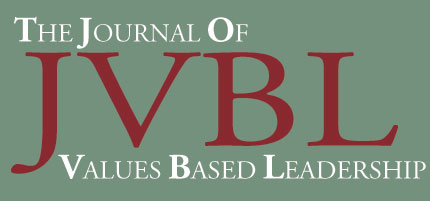- CONTENTS:
- Letter from the EditorArticle SummariesDedication and RemembranceEmploying the Seven Army Values to Win Hearts and MindsCommentary: The Business of Warfare: "Winning Hearts and Minds"Conflict Resolution: Cultural Understanding ImperativeThe Personal Values of School Leaders in Pakistan: A Contextual Model of Regulation and InfluenceThe Needs of the Stakeholders are the Seeds of Growth for the Organisation: Vignettes of Wisdom from Mr. G. NarayanaThe Character X Factor in Selecting Leaders: Beyond ethics, virtues, and valuesA Model for Implementing a Successful Sustainability StrategyEngaged Leadership: New Concept or Evolutionary in Nature?

- COMMENTARY: THE BUSINESS OF WARFARE: "WINNING HEARTS AND MINDS"
SUSANNAH MARIE GINGERICH-LARSON, DEPAUL UNIVERSITY, CHICAGO, ILLINOIS
The partnership of business and war is seemingly ironic, but certainly not a novel concept. In certain aspects, the fundamentals of business can be applied to the operations of war. Like a business venture, warfare involves risk factors, cost analyses, strategy, and tactics. War is often profitable from a sheer economic viewpoint. It may not be too surprising that U.S.. weaponry is rivaling agricultural products as America‘s largest export.1 The Norwegian nationalist who took over 75 lives on July 22, 2011, in his protest against immigration, obtained his ammunition via U.S.. mail orders as the direct sale of these items is illegal in his home country.2 World War II exemplified the uneasy reality that while the devastation of war is ubiquitous and indelible, an economy may be injected with new life through the creation of jobs and the increased production of weapons and supplies. And since the beginning of the war in Afghanistan on October 7, 2001, companies such as Raytheon – one of the largest defense contractors in the U.S.. and in the world – greatly increased its production of bombs and missiles, realizing tremendous profits albeit at the expense of the lives of civilians and soldiers.3 Lockheed Martin, also one of the world‘s largest defense contractors, received 74% of its revenue in 2009 from military sales with the Pentagon paying 7.1% of these funds. In fact, U.S.. Government contracts generated $38.4 billion for the company in 2009 alone.4
After more than a decade at war in Afghanistan, the American economy is still suffering despite the extraordinary earnings of only a handful of companies. In fact, it is projected that by the end of the 2011 fiscal year, the total cost expended for U.S.. efforts in Afghanistan will reach $118.6 million without a concomitant boost in the employment sector.5 The war has also changed its focus since its start. The original mission was to find and capture members of the Taliban and Al Qaida in response to the attacks on September 11, 2001. More recently, the primary objectives have encompassed the rebuilding and restructuring of a nation to promote a more democratic system of government through winning the trust and allegiance of the Afghani people. Although the goals of this war may seem to be more principled, measurable progress appears uncertain. As objectives change in this manner, queries still abound. Are the risks worth it?
In warfare, can this type of mission ever genuinely be accomplished? In an effort to rebuild the country, troops are helping to provide new schools, government buildings, roads, railroads, markets, and agricultural assistance among many other efforts. Conversely, roads and buildings – even mosques – have been destroyed in order to increase safety, eliminate enemy hiding places, and clear towns of explosives left by the Taliban. The local townspeople, however, have expressed mixed responses to these actions. Many are thankful, yet others have taken offense to the destruction and have little hope the efforts will end Taliban activity. In fact, some have opined that U.S.. military presence ignites Taliban aggression and that the country would be in a more favorable position without such intervention, especially since the total Afghani civilian death and causality statistics have increased by 31% this year.6
While many still support U.S.. presence, it is understandable why the Afghani population might not be so confident in such restructuring objectives since past interventions have failed, and in many cases, disastrously. In the 1970's, the Soviet Union attempted to restructure the Afghani nation, resulting in a 10-year occupation, the deaths of 2 million civilians7 and the creation of 6 million refugees who relocated to neighboring countries.8 Ostensibly, the citizens of Afghanistan have experienced incredible hardship whether the objectives of warfare have been territorial, terroristic, or designed with a more eleemosynary mission to offer long-lasting social assistance and governmental stability. The Taliban, of course, are a dangerous group who cannot be ignored, but at what cost? This new brand of warfare which attempts to win Afghani loyalty in order to change an unstable governmental and societal system is accompanied by extraordinarily high risks. Can this process authentically be branded a more principled business operation when it involves altering the entire operations under which a country is led? Can human suffering and cultural manipulation even be considered something worth putting one life at risk to reach the targeted goal – i.e., the bottom line – especially when the bottom line is far from accomplishment and the tactics of achieving same are perceived as controversial by many? One thing is certain. The business of war has been historically profitable to certain companies and sectors of society.
The business ethics of warfare, however, are nebulous and amorphous at best.
1Kimes, Mina (2011). America’s Hottest Export: Weapons. Fortune. Last accessed August 3, 2011: http://money.cnn.com/2011/02/10/news/international/america_exports_weapons_full.fortune/index.htm
2The Norway Attacks, July 27, 2011. Last accessed August 3, 2011: http://www.boston.com/bigpicture/2011/07/the_norway_attacks.html
3Raytheon generates an annual average profit of $20 billion of which over 90% is generated through “no bid” defense contracts with the U.S. State Department. Kenney, Dan (2009). “Can there be a ‘Good’ Military Contractor?” Prairie Voice, December 19, 2009.
4Hartung, William (2011). “Is Lockheed Martin Shadowing You?” Mother Jones. Last accessed July 10, 2011: http://motherjones.com/politics/2011/01/is_lockheed_martin_shadowing_you#xdm_e=http%3A%2F%2Fmotherjones.com&xdm
5Cost of Iraq, Afghanistan and Anti-Terrorism Operations, Journalist's Resource. Last accessed July 10, 2011: http://journalistsresource.org/studies/government/international/cost-Iraq-Afghanistan-terror/
6 “The Battle for Afghan Hearts and Minds,” National Public Radio, August 10, 2010. Last accessed July 10, 2011: http://www.npr.org/templates/story/story.php?storyId=129112351
7Afghanistan (1979-2001), Users.erols.com. Last accessed July 10, 2011: http://users.erols. com/mwhite28/warstat2.htm#Afghanistan
8 “Refugee Admissions Program for Near East and South Asia,” Bureau of Population, Refugees, and Migration. Last accessed July 10, 2011: http://www.state.gov/g/prm/rls/117283.htm

